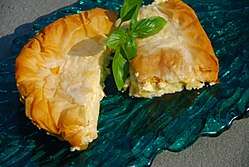Tiropita
 Tiropita with garnish | |
| Type | Börek |
|---|---|
| Place of origin |
|
| Main ingredients | Phyllo, cheese |
| Wikibooks has a book on the topic of: tyropita |
Tiropita or tyropita (τυρóπιτα 'cheese-pie') is a Greek layered pastry food in the börek family, made with layers of buttered phyllo and filled with a cheese-egg mixture.[1]
Origin
It has been suggested that it descends from the Byzantine dish called plakountas tetyromenous and en tyritas plakountas (Byzantine Greek: εν τυρίτας πλακούντας) "cheesy placenta," itself a descendant of placenta (food), a baked layered cheese dish in Roman cuisine.[2][3][4] Cato included a recipe for placenta in his De Agri Cultura (160 BC).[5]
Shape the placenta as follows: place a single row of tracta along the whole length of the base dough. This is then covered with the mixture [cheese and honey] from the mortar. Place another row of tracta on top and go on doing so until all the cheese and honey have been used up. Finish with a layer of tracta...place the placenta in the oven and put a preheated lid on top of it.
Another theory is that layered dishes like tiropita have their origins in Turkish cuisine and may trace back to layered pan-fried breads developed by the Turks of Central Asia before their westward migration to Anatolia in the late Middle Ages.[6][7] (cf. Baklava)
Variants
Another variety is the spiral Skopelos Cheese Pie in which long strips of cheese stuffed phyllo are formed into a spiral and baked or deep fried.
Tiropita can also be made in a large pan (ταψί [taˈpsɪ]) and cut into individual portions after baking. The individual form is sold in bakeries throughout Greece, where it is a popular breakfast and snack food. Alternatives to tiropita are spanakopita, a pie with spinach, as well as bougatsa or even cremidopita, an onion pie.
In Greece, one can find many varieties of Tyropita:
- Kourou: Surrounded by a thick pastry.
- Sfoliata: Surrounded by puff-pastry.
- Horiatiki: Made in a Tapsi pan.
- Tyropitakia: Bite-sized.
- Skopelitiki: Made in the shape of a twirl like a pastry
Regular tiropita fillings usually consist of feta cheese, egg, butter and yogurt. However, "kasseropita" contains kasseri instead of feta cheese and, unlike regular tiropita, does not contain yogurt.
Tiropita is usually eaten in the mid-morning by Greeks. Breakfast consists only of coffee and sometimes buttered bread. Then a mid-morning snack may consist of tyropita (more commonly) or spanakopita.
See also
References
- ↑ Tyropita (Cheese puffs)
- ↑ Rena Salaman, "Food in Motion the Migration of Foodstuffs and Cookery Techniques" from the Oxford Symposium on Food Cookery, Vol. 2, p. 184
- 1 2 Faas, Patrick (2005). Around the Roman Table. University of Chicago Press. pp. 184–185. ISBN 0226233472.
- ↑ Speros Vryonis The Decline of Medieval Hellenism in Asia Minor, 1971, p. 482
- ↑ Cato the Elder. "De Agricultura".
- ↑ Algar, Ayla Esen (1985). "The Complete Book of Turkish Cooking". ISBN 0-7103-0334-3.
- ↑ Perry, Charles. "The Taste for Layered Bread among the Nomadic Turks and the Central Asian Origins of Baklava", in A Taste of Thyme: Culinary Cultures of the Middle East (ed. Sami Zubaida, Richard Tapper), 1994, ISBN 1-86064-603-4.